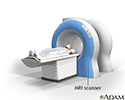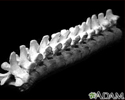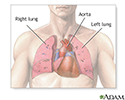Chest MRI
Nuclear magnetic resonance - chest; Magnetic resonance imaging - chest; NMR - chest; MRI of the thorax; Thoracic MRIA chest MRI (magnetic resonance imaging) scan is an imaging test that uses powerful magnetic fields and radio waves to create pictures of the chest (thoracic area). It does not use radiation (x-rays).
x-rays
X-rays are a type of electromagnetic radiation, just like visible light. An x-ray machine sends individual x-ray waves through the body. The images...

How the Test is Performed
The test is done in the following way:
- You may be asked to wear a hospital gown or clothing without metal fasteners (such as sweatpants and a t-shirt). Certain types of metal can cause blurry images or be dangerous to have on in the scanner room.
- You'll lie on a narrow table, which slides into the large tunnel-shaped scanner.
- You must be still during the exam, because movement causes blurred images. You may be told to hold your breath for short periods.
Some exams require a special dye called contrast. The dye is usually given before the test through a vein (IV) in your hand or forearm. The dye helps the radiologist see certain areas more clearly. A blood test to measure your kidney function may be done before the test. This is to make sure your kidneys are healthy enough to filter the contrast.
IV
Intravenous means "within a vein. " Most often it refers to giving medicines or fluids through a needle or tube inserted into a vein. This allows th...
Read Article Now Book Mark ArticleDuring the MRI, the person who operates the machine will watch you from another room. The test most often lasts 30 to 60 minutes, but it may take longer.
How to Prepare for the Test
You may be asked not to eat or drink anything for 4 to 6 hours before the scan.
Tell your health care provider if you are claustrophobic (afraid of closed spaces). You may be given a medicine to help you feel sleepy and less anxious. Your provider may suggest an open MRI, in which the machine is not as close to your body.
Before the test, tell your provider if you have:
-
Brain aneurysm clips
Brain aneurysm
An aneurysm is a weak area in the wall of a blood vessel that causes the blood vessel to bulge or balloon out. When an aneurysm occurs in a blood ve...
 ImageRead Article Now Book Mark Article
ImageRead Article Now Book Mark Article - Artificial heart valves
- Heart defibrillator or pacemaker
Pacemaker
A pacemaker is a small, battery-operated device. This device senses when your heart is beating too slowly. It sends a signal to your heart that mak...
 ImageRead Article Now Book Mark Article
ImageRead Article Now Book Mark Article - Inner ear (cochlear) implants
- Kidney disease or are on dialysis (you may not be able to receive contrast)
- Recently placed artificial joints
- Vascular stents
Stents
A stent is a tiny tube placed into a hollow structure in your body. This structure can be an artery, a vein, or another structure, such as the tube ...
 ImageRead Article Now Book Mark Article
ImageRead Article Now Book Mark Article - Worked with sheet metal in the past (you may need tests to check for metal pieces in your eyes)
The MRI contains strong magnets, so metal objects are not allowed into the room with the MRI scanner. This is because there is a risk that they will be drawn from your body toward the scanner. Examples of metal objects you will need to remove are:
- Pens, pocket knives, and eyeglasses
- Items such as jewelry, watches, credit cards, and hearing aids
- Pins, hairpins, and metal zippers
- Removable dental work
Some of the newer medical devices described above are MRI compatible, so the radiologist needs to check the device manufacturer to determine if an MRI is possible.
How the Test will Feel
An MRI exam causes no pain. If you have trouble lying still or are very nervous, you may be given medicine to relax. Too much movement can blur MRI images and cause errors when the radiologist or provider looks at the images.
The table may be hard or cold, but you can ask for a blanket or pillow. The machine produces loud thumping and humming noises when turned on. You can wear ear plugs to help reduce the noise.
An intercom in the room allows you to speak to someone at any time. Some MRIs have televisions and special headphones that you can use to help the time pass.
There is no recovery time, unless you were given a medicine to relax. After an MRI scan, you can resume your normal diet, activity, and medicines.
Why the Test is Performed
A chest MRI provides detailed pictures of tissues within the chest area. In general, it is not as good at looking at the lungs as a CT chest scan, but it can be better for other tissues.
CT chest scan
A chest CT (computed tomography) scan is an imaging method that uses x-rays to create cross-sectional pictures of the chest and upper abdomen....

A chest MRI may be done to:
- Provide an alternative to angiography, or avoid repeated exposure to radiation
Angiography
An arteriogram is an imaging test that uses x-rays and a special dye to see inside the arteries. It can be used to view arteries in the heart, brain...
 ImageRead Article Now Book Mark Article
ImageRead Article Now Book Mark Article - Clarify findings from earlier x-rays or CT scans
x-rays
A chest x-ray is an x-ray of the chest, lungs, heart, large arteries, ribs, and diaphragm.
 ImageRead Article Now Book Mark Article
ImageRead Article Now Book Mark Article - Diagnose abnormal growths in the chest
- Evaluate blood flow
- Show lymph nodes and blood vessels
- Show the structures of the chest from many angles
- See if cancer in the chest has spread to other areas of the body (this is called staging -- it helps guide future treatment and follow-up, and gives you an idea of what to expect in the future)
Staging
Cancer staging is a way to describe how much cancer is in your body and where it is located. Staging helps determine where the original tumor is, ho...
Read Article Now Book Mark Article - Detect tumors, especially in the middle part of the chest (mediastinum)
Tumors
A tumor is an abnormal growth of body tissue. Tumors can be cancerous (malignant) or noncancerous (benign).
Read Article Now Book Mark Article
Normal Results
A normal result means your chest area appears normal.
What Abnormal Results Mean
An abnormal chest MRI may be due to:
- A tear in the wall, an abnormal widening or ballooning, or narrowing of the aorta, the major artery carrying blood out of the heart
Tear in the wall
Aortic dissection is a serious condition in which there is a tear in the wall of the major artery carrying blood out of the heart (aorta). As the te...
 ImageRead Article Now Book Mark Article
ImageRead Article Now Book Mark ArticleAbnormal widening or ballooning
An aneurysm is an abnormal widening or ballooning of a portion of an artery due to weakness in the wall of the blood vessel. A thoracic aortic aneury...
 ImageRead Article Now Book Mark Article
ImageRead Article Now Book Mark Article - Other abnormal changes of the major blood vessels in the lungs or chest
- Buildup of blood or fluid around the heart (pericardial effusion) or the lungs (pleural effusion)
Blood or fluid around the heart
Cardiac tamponade is pressure on the heart that occurs when blood or fluid builds up in the space between the heart muscle and the outer covering sac...
 ImageRead Article Now Book Mark Article
ImageRead Article Now Book Mark ArticlePleural effusion
A pleural effusion is a buildup of fluid between the layers of tissue that line the lungs and chest cavity.
 ImageRead Article Now Book Mark Article
ImageRead Article Now Book Mark Article - Lung cancer or cancer that has spread to the lungs from elsewhere in the body
Cancer that has spread to the lungs
Lung metastases are cancerous tumors that start somewhere else in the body and spread to the lungs.
 ImageRead Article Now Book Mark Article
ImageRead Article Now Book Mark Article - Cancer or tumors of the heart
- Cancer or tumors of the chest, such as a thymus tumor
- Disease in which the heart muscle becomes weakened, stretched, or has another structural problem (cardiomyopathy)
Cardiomyopathy
Cardiomyopathy is disease in which the heart muscle becomes weakened, stretched, or has another structural problem. It often contributes to the hear...
 ImageRead Article Now Book Mark Article
ImageRead Article Now Book Mark Article - Damage to, and widening of the large airways of the lungs (bronchiectasis)
Bronchiectasis
Bronchiectasis is a disease in which the large airways in the lungs are damaged. This causes the airways to become permanently wider. Bronchiectasis...
 ImageRead Article Now Book Mark Article
ImageRead Article Now Book Mark Article - Enlarged lymph nodes
-
Infection of the heart tissue or heart valve
Infection of the heart tissue or heart ...
Endocarditis is inflammation of the inside lining of the heart chambers and heart valves (endocardium). It is most often caused by a bacterial or, r...
 ImageRead Article Now Book Mark Article
ImageRead Article Now Book Mark Article -
Esophageal cancer
Esophageal cancer
Esophageal cancer is cancer that starts in the esophagus. This is the tube through which food moves from the mouth to the stomach.
 ImageRead Article Now Book Mark Article
ImageRead Article Now Book Mark Article - Lymphoma in the chest
-
Birth defects of the heart
Birth defects of the heart
Congenital heart disease (CHD) is a problem with the heart's structure and function that is present at birth.
 ImageRead Article Now Book Mark Article
ImageRead Article Now Book Mark Article - Tumors, nodules, or cysts in the chest
Risks
MRI uses no radiation. To date, no side effects from the magnetic fields and radio waves have been reported.
The most common type of contrast (dye) used is gadolinium. It is very safe. Allergic reactions to the substance rarely occur. However, gadolinium can be harmful to people with kidney problems who need dialysis. If you have kidney problems, tell your provider before the test.
The strong magnetic fields created during an MRI can cause heart pacemakers and other implants not to work as well. It can also cause a piece of metal inside your body to move or shift.
Considerations
Currently, MRI is not considered a valuable tool for spotting or monitoring slight changes in lung tissue. The lungs contain mostly air and are hard to image. CT scan tends to be better for monitoring these changes.
Disadvantages of MRI include:
- High cost
- Long length of the scan
- Sensitivity to movement
References
Ackman JB. Thoracic magnetic resonance imaging: technique and approach to diagnosis. In: Shephard J-AO, ed. Thoracic Imaging: The Requisites. 3rd ed. Philadelphia, PA: Elsevier; 2019:chap 3.
Jokerst CE, Gotway MB. Thoracic radiology: noninvasive diagnostic imaging. In: Broaddus VC, Ernst JD, King TE, et al, eds. Murray and Nadel's Textbook of Respiratory Medicine. 7th ed. Philadelphia, PA: Elsevier; 2022:chap 20.
Nair A, Barnett JL, Semple TR. Current status of thoracic imaging. In: Adam A, Dixon AK, Gillard JH, Schaefer-Prokop CM, eds. Grainger & Allison's Diagnostic Radiology. 7th ed. Philadelphia, PA: Elsevier; 2021:chap 1.
-
MRI scans - illustration
MRI stands for magnetic resonance imaging. It allows imaging of the interior of the body without using x-rays or other types of ionizing radiation. An MRI scan is capable of showing fine detail of different tissues.
MRI scans
illustration
-
Vertebra, thoracic (mid back) - illustration
These are twelve vertebra of the mid back. The last vertebra (on the left side of the picture) attaches to the lumbar (lower) spine, and the top vertebra (on the right) attaches to the cervical (neck) section of the back. The vertebra are broader and stronger than the cervical bones. This allows them to absorb the added pressure applied to the mid back, but they remain a common sight of injury. The vertebra are numbered from one to twelve and labeled T1, T2, T3, et cetera, from the upper most bones to the lowest.
Vertebra, thoracic (mid back)
illustration
-
Thoracic organs - illustration
The thorax is also called the chest and contains the main organs of respiration and circulation. The heart through its main artery, the aorta, pumps oxygenated blood to all parts of the body. The lungs provide oxygen to the cells of the body and eliminate carbon dioxide. Together these organs sustain some of the most critical life functions of the body.
Thoracic organs
illustration
-
MRI scans - illustration
MRI stands for magnetic resonance imaging. It allows imaging of the interior of the body without using x-rays or other types of ionizing radiation. An MRI scan is capable of showing fine detail of different tissues.
MRI scans
illustration
-
Vertebra, thoracic (mid back) - illustration
These are twelve vertebra of the mid back. The last vertebra (on the left side of the picture) attaches to the lumbar (lower) spine, and the top vertebra (on the right) attaches to the cervical (neck) section of the back. The vertebra are broader and stronger than the cervical bones. This allows them to absorb the added pressure applied to the mid back, but they remain a common sight of injury. The vertebra are numbered from one to twelve and labeled T1, T2, T3, et cetera, from the upper most bones to the lowest.
Vertebra, thoracic (mid back)
illustration
-
Thoracic organs - illustration
The thorax is also called the chest and contains the main organs of respiration and circulation. The heart through its main artery, the aorta, pumps oxygenated blood to all parts of the body. The lungs provide oxygen to the cells of the body and eliminate carbon dioxide. Together these organs sustain some of the most critical life functions of the body.
Thoracic organs
illustration
Review Date: 8/19/2024
Reviewed By: Allen J. Blaivas, DO, Division of Pulmonary, Critical Care, and Sleep Medicine, VA New Jersey Health Care System, Clinical Assistant Professor, Rutgers New Jersey Medical School, East Orange, NJ. Review provided by VeriMed Healthcare Network. Also reviewed by David C. Dugdale, MD, Medical Director, Brenda Conaway, Editorial Director, and the A.D.A.M. Editorial team.





